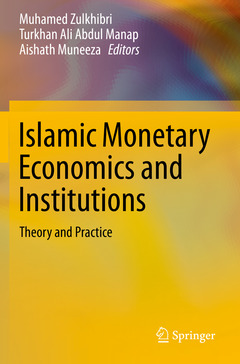Islamic Monetary Economics and Institutions, 1st ed. 2019 Theory and Practice
Coordonnateurs : Zulkhibri Muhamed, Abdul Manap Turkhan Ali, Muneeza Aishath

Explores monetary economic theory and policy in the Islamic economic and financial system
Highlights several option for authorities and regulatory bodies regarding monetary policy and regulation
Examines the interlinkage between Islamic monetary policy and other markets
Explores the ways Islamic monetary policy effects growth, financial stability and resilience to shocks in practice
Derived from the Conference on Islamic Monetary Economics and Institutions: Theory and Practice 2017 held in Malé, Maldives
Date de parution : 10-2020
Ouvrage de 201 p.
15.5x23.5 cm
Disponible chez l'éditeur (délai d'approvisionnement : 15 jours).
Prix indicatif 158,24 €
Ajouter au panierDate de parution : 10-2019
Ouvrage de 201 p.
15.5x23.5 cm
Disponible chez l'éditeur (délai d'approvisionnement : 15 jours).
Prix indicatif 158,24 €
Ajouter au panier


